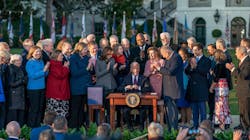Biden signs bipartisan infrastructure bill, paving way for transportation upgrades
President Joe Biden signed the more than $1 trillion bipartisan infrastructure deal into law on Monday during a ceremony on the South Lawn of the White House.
Joined by many of the lawmakers, including Sen. Rob Portman (R-Ohio), who worked for much of the year to finalize and pass the bill, Biden praised the Infrastructure Investment and Jobs Act as a rare example of the parties coming together in Washington and urged Congress to approve the other piece of his Build Back Better agenda, the "human infrastructure" package of social spending still in negotiations on Capitol Hill.
"I promised that our democracy would deliver for all of you. The bill I'm about to sign into law is proof that Democrats and Republicans can come together," said the president, who also was joined by union leaders, Vice President Kamala Harris, and House Speaker Nancy Pelosi at the ceremony. "This takes a monumental step forward in building back better."
"Compromise. We reached a consensus. That's necessary," Biden added later.
Portman, who is not running for re-election, praised the bill for "making sense for our constituents." He added, "Finding common ground for our constituents should be rewarded, not attacked." That perhaps was a nod to threats that some House Republicans faced after voting in favor of the bill last week.
"Today, we're telling the American people that an infrastructure bill is finally here," Sen. Chuck Schumer (D-New York), the Senate majority leader, said during the ceremony. There isn't a community in America that doesn't have infrastructure that needs glaring attention. This bill can be summed up with a four-letter word: jobs. Jobs, jobs, jobs."
According to the White House, spending from the package could support more than 700,000 new jobs, including more than 100,000 new jobs in the transportation industry.
About half of the $1.2 trillion legislation includes new spending, representing the most significant infrastructure investment since the interstate highway system was created. The money approved by Congress would fix roads and bridges ($110 billion), build out a nationwide electric vehicle charging—and other alternate fueling systems—infrastructure network ($7.5 billion), improve ports and waterways ($16 billion), fund public transit ($49 billion), boost freight and passenger rail ($66 billion), improve airports ($25 billion), and boost broadband internet infrastructure ($65 billion).
The day before he signed the historic legislation into law, Biden named Mitch Landrieu, a former New Orleans mayor, as the administration’s senior adviser responsible for coordinating the infrastructure law’s implementation. As mayor of one the largest cities in the U.S., Landrieu helped New Orleans oversee more than 100 projects and billions of dollars in funding to rebuild that city after Hurricane Katrina. He is also a former chairman of the U.S. Conference of Mayors and a past Louisiana lieutenant governor.
“Our work will require strong partnerships across the government and with state and local leaders, business and labor to create good-paying jobs and rebuild America for the middle class,” Landrieu said on Sunday. “We will also ensure these major investments achieve the president’s goals of combating climate change and advancing equity.”
Nearly one of every five miles of U.S. highways and major roads are in poor condition, according to federal data. About 45,000 bridges are also rated poor. The infrastructure bill reauthorizes surface transportation programs through 2026, replacing the Obama-era FAST Act. The bill also sets aside up to $1 billion per year for "nationally significant freight and highway projects" through 2026. These special projects, which would be awarded regionally through DOT grants, include programs to generate national or regional economic benefits through reduced highway congestion, improved connectivity between freight transportation modes, and other projects that address the impacts of population growth on freight and people movement.
"Passage of a comprehensive infrastructure investment bill has long been a tier-one priority for the association, which is comprised of more than 34,000 motor carriers and industry suppliers across the U.S.," according to an American Trucking Associations, which had representatives at the bill signing, in a statement issued after the ceremony. "ATA says IIJA (infrastructure Investment and Jobs Act) will bolster highway safety, make long-overdue investments in our nation’s road and bridge network, and help grow and strengthen trucking’s workforce by establishing new recruitment and training programs."
The bill will appropriate at least $52 billion per year, from 2022 to 2026, from the Highway Trust Fund for improvement and safety projects across the nation. It sets aside another $600 million to $700 million per year for a bridge investment program. That program is designed to focus on bridges currently in "poor condition" or at risk of "falling into poor condition within the next three years," according to the legislation.
Trucking industry benefits
All this spending will affect the trucking industry, which employs more than 8 million Americans and moves more than 70% of the country's freight along its roads. More than 3.5 million truck drivers move that freight along the nation's infrastructure every day.
"Of the 617,000 bridges across the U.S., nearly half of those are 50 years old," Chris Spear, president and CEO of American Trucking Associations, said in September. "And 46,000 of them are structurally deficient. Of our 4 million miles of public roads, nearly half are in poor or mediocre condition. This is embarrassing—and it's completely unacceptable."
In August, the Senate passed the spending package with a 69-30 vote, a rare show of bipartisanship in a deeply divided legislature. It took months, but the House finally approved the bill with a 228-206 vote, which included 13 Republican representatives voting for the package. Those Republican votes were needed in the House as some liberal Democrats voted against the bill.
The new law will also include programs to help recruit more people—women, minorities, and younger drivers—into the trucking industry. The bill creates a Women of Trucking Advisory Board and a pilot program that would allow drivers younger than 21 to be part of apprenticeship programs allowing them to operate in interstate commerce, which is currently against federal regulations.
While the infrastructure bill’s funding to build a nationwide network of electric vehicle charging stations received a lot of press this year, the bill also focuses on building out other alternative fueling sources—such as hydrogen, propane, and natural gas. It sets aside $300 million to $700 million per year, through 2026, for this work.
The infrastructure bill also calls for reducing truck emissions at U.S. ports. It marks $50 million per year through 2026. Ports are ideal locations for battery-electric heavy-duty trucks because of their contained areas and shorter, internal routes.
The new spending bill will also introduce more safety measures and studies for the commercial trucking industry. The bill calls for all CVs to make automatic emergency braking (AEB) systems standard within two years. It makes rear underride guards on trailers standard and the legislation calls for studies of side underride guards on trailers.
Another of the many studies called for within the bill is a look at "commercial motor vehicle crash causation." It calls for the DOT to determine the causes and contributing factors to commercial vehicle crashes by monitoring data and trends to develop safety improvements and policies.
About the Author
Josh Fisher
Editor-in-Chief
Editor-in-Chief Josh Fisher has been with FleetOwner since 2017. He covers everything from modern fleet management to operational efficiency, artificial intelligence, autonomous trucking, alternative fuels and powertrains, regulations, and emerging transportation technology. Based in Maryland, he writes the Lane Shift Ahead column about the changing North American transportation landscape.

